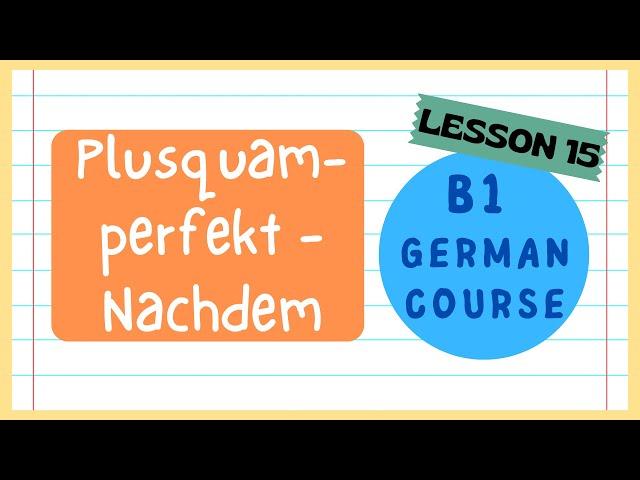
Plusquamperfekt | Nachdem | Nebensatz und Hauptsatz | B1 German Course | Lesson 15
Lesson 15 of free B1 German language course explains Plusquamperfect. This free lesson explains the German grammar topic, its sentence structure and examples explained in an easy way. This is also the continuity of lesson 14 with a difference that Nebensatz is placed and Hauptsatz is placed afterwards.
The Plusquamperfekt (past perfect) in German is used to describe an action that took place before another action in the past. It's similar to the past perfect tense in English, where you would say "had done," "had gone," etc.
he Plusquamperfekt is composed of two parts:
The simple past (Präteritum) form of the auxiliary verb: either haben (to have) or sein (to be).
The past participle (Partizip II) of the main verb.
When to use "haben" or "sein":
"haben" is used for most verbs, especially transitive verbs (verbs that take a direct object).
"sein" is used with verbs that denote movement or a change of state (e.g., "gehen" (to go), "sterben" (to die), "aufwachen" (to wake up)).
The Plusquamperfekt (past perfect) in German is used to describe an action that took place before another action in the past. It's similar to the past perfect tense in English, where you would say "had done," "had gone," etc.
he Plusquamperfekt is composed of two parts:
The simple past (Präteritum) form of the auxiliary verb: either haben (to have) or sein (to be).
The past participle (Partizip II) of the main verb.
When to use "haben" or "sein":
"haben" is used for most verbs, especially transitive verbs (verbs that take a direct object).
"sein" is used with verbs that denote movement or a change of state (e.g., "gehen" (to go), "sterben" (to die), "aufwachen" (to wake up)).
Тэги:
#Plusquamperfekt #what_is_plusquamperfect #when_to_use_plusquamperfekt #how_to_use_plusquamperfect #plusquamperfect_in_german_language #german_language_course #free_german_language_course #free_german_lessons_for_beginners #free_german_lessons #b1_german_course #free_german_course_b1_level #german_grammar #b1_german_grammar #complete_B1_german_course #b1_complete_course #german_course_in_urdu #perfect_and_past_tense_in_german #perfekt_und_prätertumКомментарии:
Welcome to Beggars Arkive Channel HD
The Arkive
Fragrance | karan Shergill | Avii Singh | New Punjabi Songh 2024
Desi Music Brand
【子ども4人】双子と小児科医ママの日常
女医の日常
Fannie Mae and Freddie Mac: The Breakdown
mangofinancial
Roman ReignsAttitude #shorts #attitude #wwe
N O W S T A T U S
[ENG+SUB]ㅣ드디어 그분이 오셨습니다️ㅣ장수원해요 ep.21-1
장수원해요 jangsuwonted


![Подкладка под пейзаж. Как писать небо? feat. @СтаниславБрусилов-н3ч - А. Рыжкин [ENG SUB] Подкладка под пейзаж. Как писать небо? feat. @СтаниславБрусилов-н3ч - А. Рыжкин [ENG SUB]](https://ruvideo.cc/img/upload/VUJYczc1ZVlwTE0.jpg)








![[ENG+SUB]ㅣ드디어 그분이 오셨습니다️ㅣ장수원해요 ep.21-1 [ENG+SUB]ㅣ드디어 그분이 오셨습니다️ㅣ장수원해요 ep.21-1](https://ruvideo.cc/img/upload/MFNYbElWMFR0aDU.jpg)














